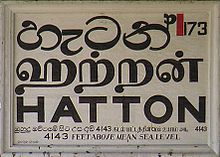Colombo – Badulla railway line
| Colombo – Badulla | |||||||||||||||||||||||||||||||||||||||||||||||||||||||||||||||||||||||||||||||||||||||||||||||||||||||||||||||||||||||||||||||||||||||||||||||||||||||||||||||||||||||||||||||||||||||||||||||||||||||||||||||||||||||||||||||||||||||||||||||||||||||||||||||||||||||||||||||||||||||||||||||||||||||||||||||||||||||||||||||||||||||||||||||||||||||||||||||||||||||||||||||||||||||||||||||||||||||||||||||||||||||||||
|---|---|---|---|---|---|---|---|---|---|---|---|---|---|---|---|---|---|---|---|---|---|---|---|---|---|---|---|---|---|---|---|---|---|---|---|---|---|---|---|---|---|---|---|---|---|---|---|---|---|---|---|---|---|---|---|---|---|---|---|---|---|---|---|---|---|---|---|---|---|---|---|---|---|---|---|---|---|---|---|---|---|---|---|---|---|---|---|---|---|---|---|---|---|---|---|---|---|---|---|---|---|---|---|---|---|---|---|---|---|---|---|---|---|---|---|---|---|---|---|---|---|---|---|---|---|---|---|---|---|---|---|---|---|---|---|---|---|---|---|---|---|---|---|---|---|---|---|---|---|---|---|---|---|---|---|---|---|---|---|---|---|---|---|---|---|---|---|---|---|---|---|---|---|---|---|---|---|---|---|---|---|---|---|---|---|---|---|---|---|---|---|---|---|---|---|---|---|---|---|---|---|---|---|---|---|---|---|---|---|---|---|---|---|---|---|---|---|---|---|---|---|---|---|---|---|---|---|---|---|---|---|---|---|---|---|---|---|---|---|---|---|---|---|---|---|---|---|---|---|---|---|---|---|---|---|---|---|---|---|---|---|---|---|---|---|---|---|---|---|---|---|---|---|---|---|---|---|---|---|---|---|---|---|---|---|---|---|---|---|---|---|---|---|---|---|---|---|---|---|---|---|---|---|---|---|---|---|---|---|---|---|---|---|---|---|---|---|---|---|---|---|---|---|---|---|---|---|---|---|---|---|---|---|---|---|---|---|---|---|---|---|---|---|---|---|---|---|---|---|---|---|---|---|---|---|---|---|---|---|---|---|---|---|---|---|---|---|---|---|---|---|---|---|---|---|---|---|---|---|---|---|---|---|---|---|---|---|---|---|---|---|---|---|---|---|---|---|---|---|---|---|---|---|---|---|---|---|---|---|---|---|
|
Train on the nine-arch bridge between Ella and Badulla
| |||||||||||||||||||||||||||||||||||||||||||||||||||||||||||||||||||||||||||||||||||||||||||||||||||||||||||||||||||||||||||||||||||||||||||||||||||||||||||||||||||||||||||||||||||||||||||||||||||||||||||||||||||||||||||||||||||||||||||||||||||||||||||||||||||||||||||||||||||||||||||||||||||||||||||||||||||||||||||||||||||||||||||||||||||||||||||||||||||||||||||||||||||||||||||||||||||||||||||||||||||||||||||
| Route length: | 292 km | ||||||||||||||||||||||||||||||||||||||||||||||||||||||||||||||||||||||||||||||||||||||||||||||||||||||||||||||||||||||||||||||||||||||||||||||||||||||||||||||||||||||||||||||||||||||||||||||||||||||||||||||||||||||||||||||||||||||||||||||||||||||||||||||||||||||||||||||||||||||||||||||||||||||||||||||||||||||||||||||||||||||||||||||||||||||||||||||||||||||||||||||||||||||||||||||||||||||||||||||||||||||||||
| Gauge : | 1676 mm ( colonial track ) | ||||||||||||||||||||||||||||||||||||||||||||||||||||||||||||||||||||||||||||||||||||||||||||||||||||||||||||||||||||||||||||||||||||||||||||||||||||||||||||||||||||||||||||||||||||||||||||||||||||||||||||||||||||||||||||||||||||||||||||||||||||||||||||||||||||||||||||||||||||||||||||||||||||||||||||||||||||||||||||||||||||||||||||||||||||||||||||||||||||||||||||||||||||||||||||||||||||||||||||||||||||||||||
| Dual track : | Colombo-Rambukkana | ||||||||||||||||||||||||||||||||||||||||||||||||||||||||||||||||||||||||||||||||||||||||||||||||||||||||||||||||||||||||||||||||||||||||||||||||||||||||||||||||||||||||||||||||||||||||||||||||||||||||||||||||||||||||||||||||||||||||||||||||||||||||||||||||||||||||||||||||||||||||||||||||||||||||||||||||||||||||||||||||||||||||||||||||||||||||||||||||||||||||||||||||||||||||||||||||||||||||||||||||||||||||||
|
|||||||||||||||||||||||||||||||||||||||||||||||||||||||||||||||||||||||||||||||||||||||||||||||||||||||||||||||||||||||||||||||||||||||||||||||||||||||||||||||||||||||||||||||||||||||||||||||||||||||||||||||||||||||||||||||||||||||||||||||||||||||||||||||||||||||||||||||||||||||||||||||||||||||||||||||||||||||||||||||||||||||||||||||||||||||||||||||||||||||||||||||||||||||||||||||||||||||||||||||||||||||||||
The Colombo – Badulla railway is a major part of the Sri Lankan railway network .
history
The line went into operation in several sections during the British colonial era . The first section from Colombo to Ambepussa was put into operation in 1864 and was also the first railway in what was then Ceylon. The extension of the line to Kandy was opened to traffic in 1867. The subsequent extension towards Badulla is mainly due to the tea that is grown here in the highlands and that could be transported comfortably and inexpensively to the port of Colombo by train.
Technology and administration
The line was built in broad gauge (1676 mm). It is 292 km long, has 78 stations and 44 tunnels . The western end of the line at Fort Colombo Station is just a few meters above sea level. The Pattipola train station is the highest in the country at 1,891 m, the apex of the line is located a little southeast of it at 1,898 m.
The western section between Colombo and Rambukkana is double-track , the continuation to the east is only single-track. The single-track section is secured with form signals and the Electric Tablet System train protection .
The line is operated by the Sri Lankan State Railways and referred to by them as the "Main Line" ( the main line). From Colombo to Rambukkana it belongs to the Colombo Railway Directorate , from Rambukkana to Badulla to the Nawalapitiya Railway Directorate .
traffic
The track is in the passenger schedule of three express pairs traveled, a night and two Tagzügen. For the latter, modern blue painted railcars built in China have been used since 2012 . As a rule, these railcars use the branching route to Matale to Kandy as a branch , turn there and return to the "Main Line" in the direction of Badulla. The others are locomotive-hauled wagon trains with 1. – 3. Class not start that Kandy. In addition to these long-distance trains, there are also a number of local trains and a freight train with passenger transport that only runs 3rd class and a 1st class observation car at the end of the train. For tourists there are now and then special trips with steam locomotives between Colombo and Kandy.
Because the eastern section of the route leads into the highlands as a mountain railway , the journey is a tourist attraction. The state railways and various private providers hang observation cars on the trains, which require first-class tickets to be used.
Operational incidents
On October 27, 1907, a serious railway accident occurred near Hatton : It had rained heavily for days. A mixed train of three passenger cars , three freight cars and a brake car , pulled by a locomotive, drove towards Colombo. At around 11:30 p.m., under the weight of the train, the softened subsoil on a section of the route on a slope, two kilometers behind Hatton station , gave way. The track and the train fell 60 meters. As there was no lighting, the recovery was difficult. 17 people died and many were injured.
Worth knowing
- The Sri Lankan National Railway Museum is located across from Kadugannawa Station .
- At the Demodara train station, the route leads through a 360 ° roundabout and crosses itself (in tunnel no. 47). This takes place two stations after the well-known “nine- arch bridge ” in Ella.
literature
- Andreas Illert: Take the train at 5:55 a.m. to tea . In: Fern-Express 3/2016, pp. 22–29.
Web links
Remarks
- ↑ railway Nanu Oya Ragala , 726 mm gauge, shortly after World War II shut down (Illert, p 26).
- ↑ The tunnels are numbered 1 to 43 from west to east. From tunnel no. 5 there is a tunnel 5A and a 5B, which was caused by re-routing (Illert, p. 27).
- ^ "Operating Region".
Individual evidence
- ↑ a b c d Illert, p. 22.
- ↑ a b Homepage: Sri Lanka Railways.
- ↑ Illert, p. 27.
- ↑ a b c d Illert, p. 23.
- ↑ a b Timetable of the Sri Lanka Railways (accessed November 2, 2016).
- ↑ a b c Illert, p. 28.
- ^ Bernhard Püschel: Historical railway catastrophes. A chronicle of accidents from 1840 to 1926 . Freiburg 1977. ISBN 3-88255-838-5 , p. 78.






